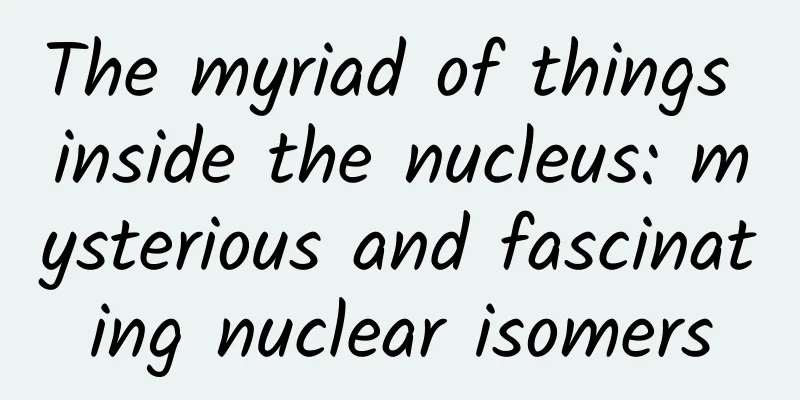The myriad of things inside the nucleus: mysterious and fascinating nuclear isomers

|
It has been more than 100 years since nuclear isomers were first discovered. From a practical application perspective, this mysterious state in the nucleus may play an important role in nuclear time scales, nuclear batteries, clean nuclear energy, and nuclear gamma-ray lasers in the future. However, scientists are still struggling to unlock their mysterious properties. Written by Jiang Lijia (School of Physics, Northwestern University) For the same element, the number of protons and neutrons in its nucleus is different, which we call isotopes of the element. So for the same isotope, are they all the same? In fact, scientists discovered long ago that when unstable isotopes decay, the nucleus also has different states, and this state even has more important applications. This has opened a new door for us to understand the nucleus - nuclear isomers. Nuclear isomers (also called isobars) are long-lived "metastable" nuclei. One or more nucleons (protons or neutrons) in this type of nucleus are excited and occupy a higher energy state than the ground state. In general, most nuclear excited states have very short half-lives, on the order of 10^(-12) seconds, and will quickly decay back to the ground state. If the half-life of an excited state is 100 to 1000 times longer than the usual excited state, it is considered to be metastable. Although there is no clear definition, in order to separate it from the usual radiative decay in time and space, the academic community currently believes that the half-life of a nuclear isomer should be greater than 5 x 10^(-9) seconds. Among the known nuclear isomers, some nuclides can decay for minutes, hours, years or longer. For example, the longest-lived nuclear isomer in nature is tantalum-180m, which has a half-life greater than 10^15 years, which is longer than the theoretical age of the universe. Figure 1. Distribution of natural nuclides (blue dots) and nuclear isomers (red dots) with excitation energy > 2 MeV and half-lives longer than 5 x 10^(-7) s. (Vertical axis - proton number Z, horizontal axis - neutron number N). Source: Reference [1] The discovery of nuclear isomers From a historical perspective, it took nearly a hundred years for nuclear isomers to go from conception to experimental and theoretical development. Radioactive elements were discovered in the early 20th century, and scientists used the half-life of an element—the time it takes for half the initial amount of the radioactive element to decay into other elements—as one of the criteria for discovering and describing a new radioactive element. In 1917, the British chemist Frederick Soddy proposed that there might be two or more long-lived (or stable) states of the same nucleus, "isotopes of the same atomic weight and chemical properties, differing in their stability and in the manner in which they decompose," a "finer isotope." In effect, what Soddy predicted are what we now call nuclear isomers, although historians of science are unsure whether subsequent scientific research was directly inspired by Soddy's work.
Figure 2. Decay process of UI (uranium-238). UI decays to UX1 through α decay, and then transitions to UX2 or UZ through β decay. Both UX2 and UZ transition to UII through β decay. Image source: Reference [4] Hahn's work marked the discovery of nuclear isomers and the birth of a new branch of the field of nuclear structure. However, our understanding of nuclear isomers has been slow to progress. At the time of those "Hahn" experiments in the 1920s, scientists still believed that atoms were a bunch of protons orbiting an equal number of electrons. It was not until 1932, when British physicist James Chadwick discovered that neutrons are also part of the atomic nucleus, that physicists were able to further understand the atomic nucleus and even nuclear isomers both theoretically and experimentally. Three types of nuclear isomers The term "nuclear isomer" first appeared in a paper by the famous physicist George Gamow in 1934. Gamow believed that similar to isomers in chemistry, by arranging protons and neutrons in different ways, the nucleus will also exhibit different energy states. The generally accepted explanation for nuclear isomers was proposed by German physicist Carl von Weizsäcker in 1936. Von Weizsäcker realized that all nucleons have spin (spin here refers specifically to angular momentum), and different arrangements of protons and neutrons in orbit can produce different orbital rotation states. If the excited state of the nucleus has a very different spin from the ground state, and a very close transition energy, the electromagnetic transition will be delayed, and accordingly, the half-life of the excited state may also be extended, forming spin isomers . Later, physicists realized that the nucleus may not be spherical, and thus developed a theory to describe the shape change of nuclei with axial symmetry. In 1955, the concept of K quantum number and the theory of K-forbidden transitions were proposed. K represents the projection of total angular momentum on the symmetry axis of the nucleus. K is not an absolute conserved quantity, so in the process of nuclear decay, K-forbidden transitions are only suppressed, not strictly prohibited. Therefore, not only the magnitude of angular momentum, but also the direction of the angular momentum vector is important, thus defining K isomers . In fact, before the K quantum number was proposed, K isomers (osmium-190 and hafnium-180) were experimentally observed in 1950 and 1951 respectively. The development of K isomer theory is based on the analysis of the rotational characteristics of the nucleus during the experimental observation of isomer decay. In 1962, Polikanov et al. discovered the third type of isomers - fission or shape isomers . The number of nucleons in fission isomers is usually in the range of proton number 90 ≤ Z ≤ 97 and neutron number 141 ≤ N ≤ 151, which belongs to a more general "shape isomer". People have found that during the decay of atomic nuclei, if the shape of the nucleons changes greatly, such as a huge change in the distribution of the orbits of a single nucleon, it will also lead to the suppression of the probability of atomic nucleus transitions, resulting in shape isomers. Figure 3. Schematic diagram of the three main types of nuclear isomers. Source: Reference [2] The above distinction is made between the three main types of isomers due to changes in spin, K and nuclear shape, but they do not usually appear alone, and the same nuclear isomer often contains mixed effects of different types. A typical example is hafnium-178, which exhibits the characteristics of both spin isomers and K isomers. Magic numbers describing nuclear structure The original "nuclear shell" model for describing the nucleus was developed independently by Maria Mayer in 1949 and by Otto Haxel, Hans Jensen, and Hans Suess. Just as in the electron shell model, each shell can hold no more than a certain number of electrons, the number of protons and neutrons that can be held in each nuclear shell in the nucleus composed of neutrons and protons is also subject to similar restrictions. The decisive step was to add spin-orbit coupling terms to the interaction. The number of nucleons that can be held in each nuclear shell is called the "magic number". From the first shell onwards, the maximum number of nucleons that can be held in each shell is 2, 8, 20, 28, 50, and 82. Unlike protons, neutrons have an additional magic number of 126. The nuclear shell model can explain and predict the ground state spin and parity of most atomic nuclei fairly well. However, the electron and nuclear shell models are not completely similar. The spin-orbit force between electrons is a weak repulsive force, while the spin-orbit force in the nucleus is a strong attractive force. The most direct impact is that when the nuclear shell is full or almost full of nucleons, there is a greater chance of forming nuclear isomers. At the same time, physicists have also discovered that the magic number of protons is also affected by the number of neutrons, and vice versa. Given that the original definition of magic numbers was based on the study of stable atomic nuclei, the fact that they may not be so magical forces us to re-examine the structure of unstable atomic nuclei. Metastable nuclear isomers will play a key role in this exploration. Application prospects of nuclear isomers Experiments have found that nuclear isomers can interact with their atomic environment in a special way, which has opened the way for research at the nuclear-atom level. We know that the ground state of radioactive nuclei can be transformed through beta decay, and sometimes through alpha decay, fission, and proton decay. But in addition to these decay processes, nuclear isomers can also decay electromagnetically through gamma rays and conversion electron emission. Therefore, people can electromagnetically manipulate nuclear isomers to achieve the exploration and application of nuclear isomers. In fact, some industries have already achieved industrial applications. Medical diagnosis and treatment: Many radioactive isotopes are used in medicine for diagnosis and treatment, of which technetium-99 isomers are the most widely used. When technetium-99 decays, it only emits gamma rays with an energy of 141 keV, without any other particles emitted, making it ideal for scanning the human skeleton, brain and heart. At the same time, its half-life is six hours, which is enough time to scan specific organs, but it can decay quickly. When ordinary radioactive elements and isotopes decay, they release charged particles that damage human tissue cells. But isomers like technetium only emit a very low energy photon at a time, which is very safe for medical use. Nuclear clock: Although the protons and neutrons in the nucleus are bound together by the strong nuclear force, they essentially occupy discrete energy levels like electrons. Therefore, in theory, the physical properties of the nucleus can be used to create a nuclear clock with higher timing accuracy. At the same time, because the nucleus can resist the influence of stray electric or magnetic fields that interfere with the atomic clock, the transition between the nuclear energy levels is more regular and stable than that of the outer electrons. In theory, a nuclear clock will be more accurate and stable than an atomic clock. Scientists have discovered that there is a pair of adjacent energy levels in the thorium-229 element with energies close enough that it is possible to trigger its transition using a laser. Therefore, the thorium-299 element is an excellent candidate for making a nuclear clock. Nuclear "batteries": A large amount of energy can be stored in nuclear isomers. If an effective method can be found to release this energy in a controlled manner, then a nuclear "battery" can be built, whose energy density may be a million times higher than that of existing chemical batteries. One way to achieve the production of a nuclear "battery" is to induce the energy release of nuclear isomers by externally applied radiation. Among them, tantalum-180 and hafnium-178 isomers, which are very stable, are good candidates. Another way is to excite the nucleus to release energy through electron emission or electron capture. Theoretical and experimental research on this method is still underway. New states of matter and gamma-ray lasers: Another interesting possibility is that a new state of matter could be created from nuclear isomers. When a gas of cesium atoms in isomer states is cooled to a temperature of 100 nanokelvin, a Bose-Einstein condensate can be formed. The atoms are in the lowest energy "condensed" state, but the isomers themselves are, by definition, excited. Therefore, a new state of matter may have been created in nuclear isomer experiments. Research into this state is still ongoing. In addition to this strange and counterintuitive state of matter, scientists have proposed that coherent gamma rays could be produced by controlling the decay of isomers in a Bose-Einstein condensate of cesium-135, which brings the creation of an ultra-powerful "gamma-ray laser" one step closer. summary A century after Hahn first discovered isomers, nuclear isomers remain a mystery to us, and scientists are working to study and find new isomers using research facilities around the world. The largest experimental facility currently is the Facility for Rare Isotope Beams (FRIB) at Michigan State University. When the facility comes online in May 2022, scientists expect to unlock more than 1,000 new isotopes and isomers. Due to their unique and rich properties, the study of nuclear isomers not only has many practical significance, but also gives us the opportunity to explore the explosion of stars and the synthesis of life elements. At the atomic-nuclear level, the special properties of nuclear isomers provide people with unique research opportunities to explore the unknown areas of nuclear physics, and there will be more extraordinary discoveries in the future. References [1] Philip Walker and Zsolt Podolyák, Phys. Scr. 95 (2020) 044004 (11pp). [2] Nature volume 399, pages35–40 (1999). [3] http://en.wiki.hancel.org/wiki/Nuclear_isomer [4] https://physicsworld.com/a/celebrating-a-century-of-nuclear-isomers/ [5]http://phys.org/news/2022-05-nuclear-isomers-years-physicists-unraveling.html [6] http://www.thoughtco.com/nuclear-isomer-definition-4129399 This article is supported by the Science Popularization China Starry Sky Project Produced by: China Association for Science and Technology Department of Science Popularization Producer: China Science and Technology Press Co., Ltd., Beijing Zhongke Xinghe Culture Media Co., Ltd. 1. Go to the "Featured Column" at the bottom of the menu of the "Fanpu" WeChat public account to read a series of popular science articles on different topics. 2. Fanpu provides a function to search articles by month. Follow the official account and reply with the four-digit year + month, such as "1903", to get the article index for March 2019, and so on. Copyright statement: Personal forwarding is welcome. Any form of media or organization is not allowed to reprint or excerpt without authorization. For reprint authorization, please contact the backstage of the "Fanpu" WeChat public account. |
<<: "Chang'an 30,000 Miles" is popular, and these details are hotly discussed by netizens
>>: What kind of insect is the "katydid" in "The Book of Songs"?
Recommend
Introduction to Cloud Desktop Transmission Protocol
1. Definition As shown in the figure, the cloud d...
Why does the sun have a cycle when it loses its temper?
It is reported that China's first comprehensi...
Android Basics: Application Components
Application components are the basic building blo...
In one second, 1 million cells in the human body die! The “death” methods are different...
Death may seem like a pure loss, but if we zoom o...
Inventory of classic running video types in information flow
Everyone should be familiar with the financial in...
Tik Tok Promotion: Does Tik Tok win by its algorithm?
Tik Tok is addictive, don't get addicted to i...
Summary of my experience at Baidu and Meituan: How to build an operations team from scratch!
From entrepreneurship to Baidu, and then to Meitu...
Qinghai restaurants resume business! Can hotels also open? What are the requirements during business hours? Attached is the full text of the announcement!
The 2020 restaurant resumption notice has always ...
To do a good job of through train promotion, we need to simplify the cumbersome
Almost all real sellers have used Through Train. ...
All YOGA products have been updated. What can Lenovo do to challenge Microsoft Surface?
Nowadays, domestic mobile phones like to "be...
AI consciousness has "awakened", but humans are still kept in the dark?
We need AI to be smarter, not conscious. Without ...
Hengshui Mini Program Customization Company, how much does it cost to customize a home mini program?
The mini program provides convenience for publici...
Reference data for 11 categories of second-tier e-commerce on the Qutoutiao platform
Today I’d like to share with you a wave of second...
Mars also has its own New Year? Future Martians, come and see how to celebrate the Martian New Year
Image generation: Doubao AI The Martian New Year ...







![[Case] Teach you how to organize activities, the highest level of activity operation: product activation VS activity productization!](/upload/images/67cc18e4ddcd3.webp)

